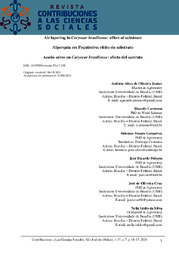Air layering in Caryocar brasiliense: effect of substrate.
Air layering in Caryocar brasiliense: effect of substrate.
Author(s): OLIVEIRA JUNIOR, A. A. de O.; CARMONA, R.; GONCALVES, H. M.; PEIXOTO, J. R.; CRUZ, J. de O.; SILVA, N. I. da
Summary: The commercial propagation of Caryocar brasiliense Cambess is hindered by several factors, including seed dormancy and low cutting survival rates. Air layering studies are needed to overcome these limitations. Previous studies have reported the influence of substrates on the rooting of air layers for different species. Therefore, the objective of this study was to evaluate the influence of substrates on air layering of Caryocar Brasiliense. An experiment was conducted with eight stock plants located at Embrapa Cerrados, Distrito Federal, Brazil, using different substrates, including Bioplant®, coconut fiber, a mixture of Bioplant® and coconut fiber in 3:1, 1:1, 1:3 proportions, rice husk biochar, vermiculite, sawdust, soil, and sand. Each treatment was replicated four times. After five months, the survival rate, callus formation, rooting percentage, root length, fresh and dry root mass, and rooting vigor were evaluated. The survival and callus formation rates in all substrates were above 95%. Bioplant® substrate provided the highest rooting percentage (77%), fresh and dry root mass (17.08g and 3.16g, respectively), while soil provided the lowest rooting percentage (17%) and fresh and dry root mass (0.1g and 0.02g, respectively). The average root length was 6.63 cm in the 1:1 mixture. Based on the evaluated characteristics, Bioplant® is the most suitable substrate for the propagation of C. brasiliense stock plants by air layering. The results suggest that air layering is a viable alternative to the vegetative propagation of Caryocar brasiliense stock plants.
Publication year: 2024
Types of publication: Journal article
Unit: Embrapa Cerrados
Keywords: Callus formation, Cerrado, Clonagem, Enraizamento, Plant propagation, Rooting
Observation
Some of Embrapa's publications are published as ePub files. To read them, use or download one of the following free software options to your computer or mobile device. Android: Google Play Books; IOS: iBooks; Windows and Linux: Calibre.
Access other publications
Access the Agricultural Research Database (BDPA) to consult Embrapa's full library collection and records.
Visit Embrapa Bookstore to purchase books and other publications sold by Embrapa.

